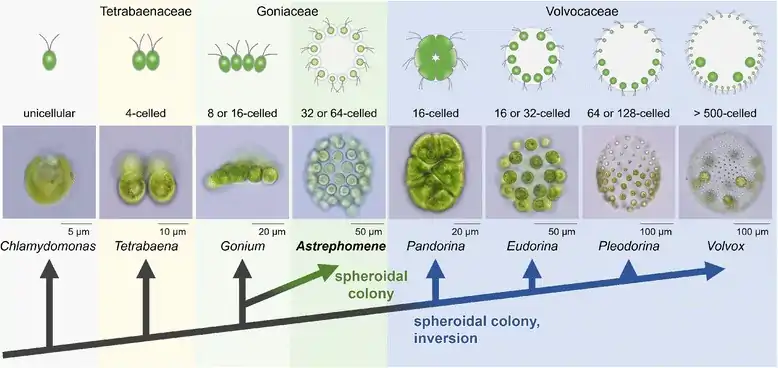| Astrephomene | |
|---|---|
| Scientific classification | |
| (unranked): | Viridiplantae |
| Division: | Chlorophyta |
| Class: | Chlorophyceae |
| Order: | Chlamydomonadales |
| Family: | Goniaceae |
| Genus: | Astrephomene Pocock |
| Species | |
| |
Astrephomene is a genus of green algae in the family Goniaceae, order Chlamydomonadales.[1][2] The genus was first described in 1937 by Pocock and named by Pockock in 1953 (Stein 1958).
Taxonomy
It was formerly placed in the monotypic family Astrephomenaceae. Astrephomenaceae is now considered obsolete, and Astrephomene is now classified within the Goniaceae.[3]
Description
Astrephomene gubernaculifera is a colonial, flagellated volvocine green algae. It consists of 16, 32, 64 or 128 cells, 2 to 7 of which are small and oriented such that their flagella form a rudder (Stein 1958). Each cell is surrounded by a gelatinous matrix and contains an eyespot, two flagella and 1-3 contractile vacuoles at the anterior end.
Astrephomene gubernaculifera can reproduce sexually or asexually. During asexual reproduction of Astrephomene, rotation of daughter protoplasts occurs in conjunction with the movement of basal bodies during successive cell divisions, ending with the anterior end of all cells of the daughter colony outside after the first nuclear and cytoplasmic division.[4] This type of asexual reproduction is unique among the colonial volvocine green algae (Pocock 1953). By contrast, in Eudorina, protoplast rotation is lacking during successive divisions; a spheroidal colony is formed by means of inversion after successive divisions. Astrephomene gubernaculifera has two mating types that reproduce to form zygotes.

Evolution
Colony inversion is believed to have arisen twice in the order Chlamydomonadales. Spheroidal colony formation differs between the two lineages: rotation of daughter protoplasts during successive cell divisions in Astrephomene, and inversion after cell divisions in Eudorina.[4]

Habitats
Astrephomene gubernaculifera is often found in organically rich temporary pools, often in pasture ponds. It typically persists for 1–3 weeks after ponds are formed in beginning of the wet season (Pocock 1953).
It has been collected from South Africa, Australia and the United States (Pocock 1953).
References
- ↑ Nozaki, H.; Kuroiwa, T. (1992). "Ultrastructure of the extracellular matrix and taxonomy of Eudorina, Pleodorina and Yamagishiella gen. nov. (Volvocaceae, Chlorophyta)". Phycologia. 31 (6): 529–541. doi:10.2216/i0031-8884-31-6-529.1.
- ↑ See the NCBI webpage on Astrephomene. Data extracted from the "NCBI taxonomy resources". National Center for Biotechnology Information. Retrieved 2007-03-19.
- ↑ Nozaki, H.; Kuroiwa, T. (1992). "Ultrastructure of the extracellular matrix and taxonomy of Eudorina, Pleodorina and Yamagishiella gen. nov. (Volvocaceae, Chlorophyta)". Phycologia. 31 (6): 529–541. doi:10.2216/i0031-8884-31-6-529.1.
- 1 2 3 Yamashita, S.; Arakaki, Y.; Kawai-Toyooka, H.; Noga, A.; Hirono, M.; Nozaki, H. (2016). "Alternative evolution of a spheroidal colony in volvocine algae: Developmental analysis of embryogenesis in Astrephomene (Volvocales, Chlorophyta)". BMC Evolutionary Biology. 16 (1): 243. doi:10.1186/s12862-016-0794-x. PMC 5103382. PMID 27829356.
 This article incorporates text from this source, which is available under the CC BY 4.0 license.
This article incorporates text from this source, which is available under the CC BY 4.0 license.
Further reading
Scientific journals
- Nozaki H, Onishi K, Morita E (2002). "Differences in pyrenoid morphology are correlated with differences in the rbcL genes of members of the Chloromonas lineage (Volvocales, Chlorophyceae)". J Mol Evol. 55 (4): 414–430. Bibcode:2002JMolE..55..414N. doi:10.1007/s00239-002-2338-9. PMID 12355262. S2CID 19862929.